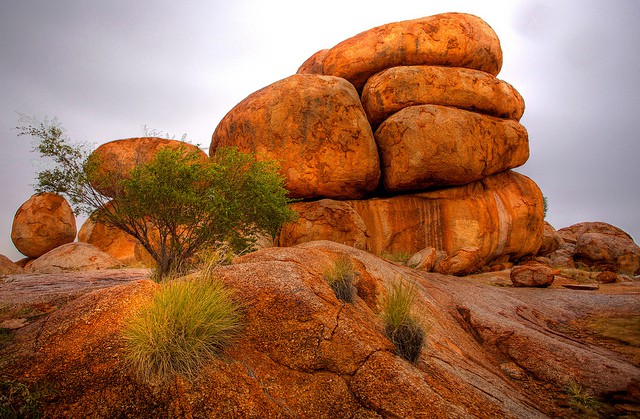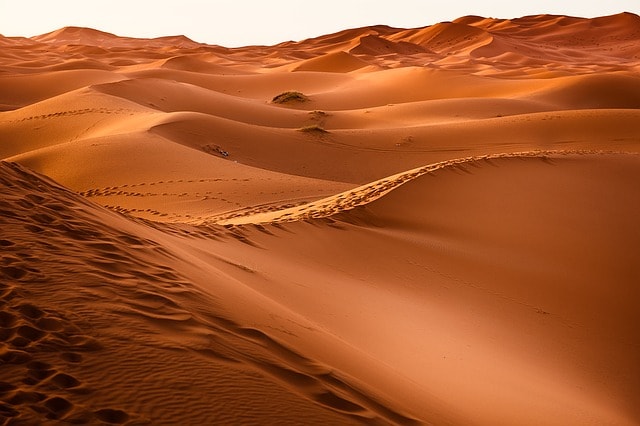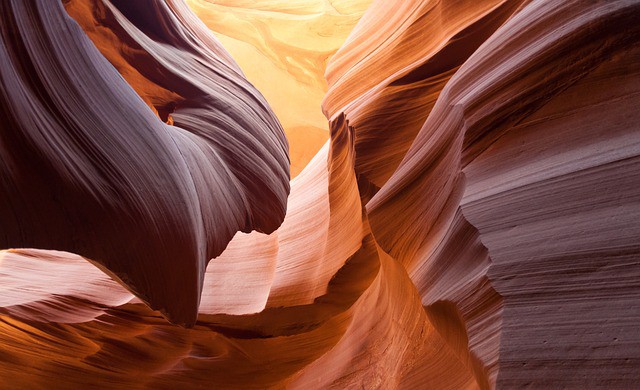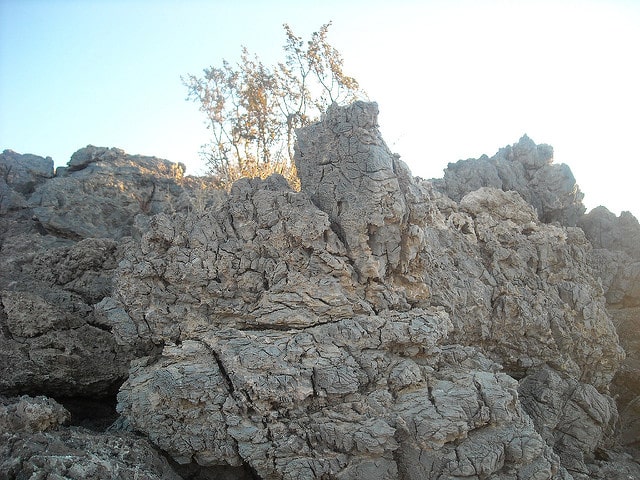Limestone – Formation, Composition, Types and Uses
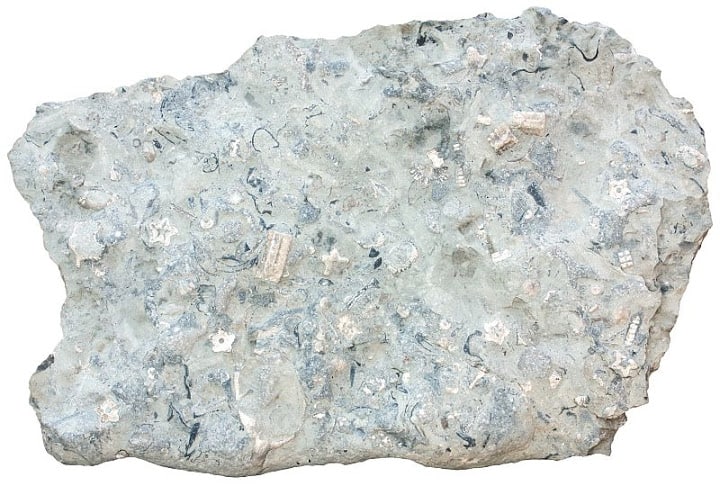
Limestone, or calcium carbonate, is the common rock found throughout the world. Oldest and perhaps slightly overlooked, limestone is very much part of our everyday life. It may be hidden with your walls, in the water you drink, the food you consume, or in the cosmetics.
First discovered by Belsazar Hacquet in 1778, Limestone is a sedimentary rock composed chiefly of calcite, CaCO3, and constitutes 10% of the total volume of all sedimentary rocks.
Where Does Limestone Come From?
From the geological perspective, limestone formation takes place in two different environments, sedimentation in marine waters and by water evaporation during cave formation.
Marine Environment to Form Limestone
Most limestones form in clear, shallow marine waters – an environment where organisms can form calcium carbonate shells. Deep ocean water is home to single cellular organisms to whales.
When these organisms (especially mollusks, echinoids and corals) die, the skeletal remains with calcium settle on the ocean floor as sedimentary layers. Over time, these sedimental layers get lithified to become limestone. The limestone like ooids contains are made of carbonate grains.
The lower limit for limestone accumulation in the ocean is approximately 4,000 m. Beneath that depth, calcite is soluble so accumulation is impossible.
Limestone Formation By Water Evaporating Environment
Some limestones are formed through evaporation in caves where water seeps/pours through the cave floor. Upon evaporation, calcium carbonate dissolved in water gets deposited throughout the cave ceiling and wall. Over thousands of years, they transform into larger deposits and may even reach into the deepest parts of the cave.
Where is Limestone Found?
Geologists have identified numerous limestone-forming environments around the globe. Most of them are in shallow waters between 30º N latitude and 30º S latitude. Most popular shallow water areas include the Caribbean Sea, Indian Ocean, Persian Gulf, and the Gulf of Mexico. Pacific Ocean islands and Indonesian archipelago regions are also rich in limestone depositions.
What is Limestone Made up of?
The limestone is mostly made up of one of two types of mineral – calcite or aragonite. Both of these are different crystal arrangements of calcium carbonate (CaCO3). All limestones contain at least 50% calcium carbonate by weight. Limestones also contain a considerable amount of magnesium carbonate (MgCO3), also known as dolomite. Minor constituents include clay, iron carbonate, siderite, sulfate, feldspar, pyrite, and quartz.
Pure limestone is white or almost white. Because of impurities, many limestones exhibit different colors ranging from pale to beige, gray, yellow, or blue.
Types of Limestone
Most limestones are marine deposits, but some are formed in lakes, river basins, and on land.
Limestones consisting mainly of animal shells
The shells of many aquatic animals consist of calcium carbonate (calcite and aragonite). When they die, their shells are left on the ocean floor, lake bottom, or river bed where they accumulate into thick deposits. Some examples include,
- Crinoidal Limestones – Limestones with a significant amount of crinoid fossils. Also known as sea lilies, Crinoids are marine echinoderms. Limestones of the Pennsylvanian and Permian aged rocks of Kansas region is a great example.
- Fusilinid Limestones – Limestones with solid masses of fusulinids shells. The Fusilinid is a Foraminiferan order; the single-celled animals have shells with secreted microgranular calcite.
- Reef-like Limestones – Formed from fossil remains of aquatic fauna and flora including corals, trilobites, brachiopods, gastropods, bivalves, etc. They are more abundant in shallow tropical seas.
- Shell limestones – Contain remains of corals, clams, oysters, and brachiopods. They can be either small, elongated deposits or several hundred miles in length. They were originally deposited in very shallow seas.
Limestones formed partly by chemical processes
- Algal Limestone – Algae is a broad group of aquatic plants that includes seaweeds and pond scums. Like all plants, they consume carbon dioxide thus allowing for calcium carbonate precipitation. Algal limestones are full of remains of such calcium-carbonate-producing algae. Pennsylvania and Permian limestones of eastern Kansas are partially formed by algae.
- Oolitic limestone – A limestone composed mainly of calcium carbonate Oolites. Oolite or egg stone is a sedimentary rock formed from ooids, spherical grains, or shell particles (less than 2 mm in diameter) coated with calcite. They are commonly seen in Johnson, Miami, Linn, ad Bourbon counties.
- Chalk – A fine-grained, white limestone formed from the calcareous shell remains of foraminifers, or marine algae such as coccoliths. Much chalk was deposited during the Cretaceous Period of, says the geological evidence collected from the chalks across the world. Pure chalk is white but weathers white, yellow, or orange.
Expensive deposits of chalks are all over the world; the White Cliffs of Dover in the UK, Niobrara Chalk and Monument Rocks in Kansas, etc are some popular examples.
- Diatomaceous Marl – When the diatom, a single-celled alga, die, their outer shell (silica) settle to the sea or lake bottom and accumulate. Over time, they become what we call Diatomaceous Marl. Example: Ogallala Formation of Wallace and Logan counties.
- Travertine – It is a compressed form of limestone formed by evaporative precipitation of calcium carbonate in hot springs or limestone caves. Travertine is the major constituent of stalactites and stalagmites, the rock formations seen in caves. Mammoth Hot Springs in Yellowstone National Park, and Carlsbad Caverns, New Mexico are found actively depositing travertine.
- Tufa – yellowish to brown limestone formed by the biological and chemical precipitation of calcite from cold or hot springs, lakes, or streams where the waters have a high concentration of calcium carbonate. Mostly it’s due to the algal and bacterial metabolism as the process involves high consumption of carbon dioxide, resulting in saturation of calcium carbonate.
- Coquina – This type of limestone contains sorted and cemented fossils of mollusks, trilobites, brachiopods, or other invertebrates. It contains very little impurities – silt or clay-size particles – making it extremely soft and porous.
Common Uses for Limestone
1. Building
Limestone was a popular choice of architectural material in past centuries – the pyramids at Giza and the Roman Colosseum, for example. A Canadian city – Kingston – is called ‘the limestone city’ because of its magnificent limestone heritage buildings. And, it still is a popular construction material because of weather resistance and aesthetics.
2. Concrete
Many of today’s construction works rely on concrete. Limestone is the main component of the cement that binds concrete together, making it unavoidable to almost all modern buildings.
3. Soil pH Balance
Because limestone naturally increases pH, it is used to neutralize acidic soil. This also helps release soil minerals, such as phosphates, and making them readily available for plants. The crushed stone, called agricultural lime, is added to the soil for better productivity.
4. Medications
Limestone’s power to neutralize acid also makes it an important component of prescription drugs for heartburn and reflux. Calcium carbonate is even used as a phosphate binder for treating hyperphosphatemia.
5. Chemical Applications
Limestone’s chemical properties allow it to bond to sulfur dioxide and silica. For this reason, it is used in fuel gas desulfurization to remove toxic emissions from fossil-fuel power plants, remove impurities from iron, and control the viscosity of glass during glassmaking.
6. Animal Feed
Animals need calcium for healthy growth and development. Ground limestone powder is a healthy and viable solution instead of bones. Limestone containing animal feed is a popular choice for pig beef, cattle, poultry, horses, and sheep.
7. Plaster of Paris
Plaster of Paris (POP) is the preferred material for making decorative sculptures and metal castings. Plaster of Paris cast is used extensively in orthopedic applications. POP is based on calcium minerals and uses limestone in abundance.
8. Raw Material
Limestone is used as the raw material for the manufacture of quicklime (calcium oxide), slaked lime (calcium hydroxide), cement, and mortar.
9. Filter
Limestone has great neutralizing power against toxins and hazardous chemicals. For this reason, Limestone aggregates and crushed particles of varying sizes are used to create sewage and other filtering applications.
10. Soda Ash
Limestone is used to produce soda ash (sodium carbonate, Na2CO3). Soda ash serves as an alkali in the chemical industry, with applications in paper, soap and detergent manufacture, tanning, water treatment, and industrial waste treatment.
11. Cosmetics
Limestone is an essential component of many makeup products including fillers.
Other uses include,
- as a flux in smelting iron ore
- whiting material in paint, plastics, and rubber
- in blast furnaces to remove impurities from iron
To sum things us, here are 5 interesting limestone facts.
- Limestone is available in just about any color depending upon which elements are combined with the calcium carbonate in it. This sedimentary rock is ordinarily white otherwise.
- Limestone is rarely 100% pure due to impurities. Salem Limestone is considered chemically pure—it is about 97 percent calcium carbonate.
- Crystal healers consider limestone as a healing stone benefitting overall health and wellbeing. It gives relief for muscle spasms and activates the Root Chakra in the body.
- Back in the 1700s, lithography incorporated limestone, where pictures were drawn and copied on beautiful stones.
- The casing stones on the Great Pyramids of Egypt are limestone.
References:
https://dnr.mo.gov/geology/docs/MineralChemLimestone.pdf
https://www.britannica.com/science/limestone
https://link.springer.com/article/10.1007/s10064-019-01620-0

